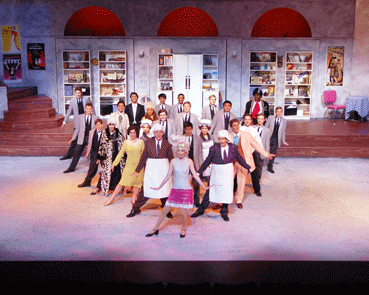Hannon Theatre Company's May 2012 production of The Drowsy Chaperone reinforced via Loyola High School's new L-Acoustics KIVA system
Hannon Theatre Company (HTC) at Loyola High School, the oldest secondary school in Southern California, has long been recognized for pushing its students to stage theatrical productions that are nothing short of professional-grade. As part of a continuing effort to improve overall quality, the downtown L.A. school chose to dramatically upgrade its technical production facilities this past season with the addition of an L-Acoustics KIVA system.
Designed and installed by Electrosonic of Burbank, the new system features a single central mono array of six ultra-compact KIVA line source enclosures flanked on either side by a KILO low-frequency extension cabinet. Down below, two SB18i subwoofers further augment the bass reinforcement, while a single LA8 amplified controller drives the entire system.
"When the school approached me and asked how they could improve the sound, the L-Acoustics KIVA system immediately came to my mind," said Electrosonic's Bryan Hinckley. "The venue was originally built in the 1920s as a wooden basketball gym with a steel vaulted ceiling and then converted into a performance arts space 30 years ago, so its acoustics are less than ideal. But I knew that KIVA would be an effective solution for focusing energy on the audience and avoiding the ceiling and back wall, which had previously been problematic."
Electrosonic installed and commissioned the system just a week prior to the school's fall 2011 drama production of Thornton Wilder's classic, The Matchmaker, which received considerable praise from audiences on its improved sound quality. But it was HTC's spring 2012 musical adaptation of The Drowsy Chaperone in early May that best showed off the capabilities of the new rig.
"Our spring musical sounded amazing!" enthused HTC technical director Eric Hermanson, who has worked with the troupe for the past dozen seasons. "The feedback line in this room has always been impossible to manage, especially when trying to get actors' voices over an electronically-amplified 10-piece orchestra. But this year it was no problem. I could literally walk actors right out to the front row and have them be perfectly intelligible over the orchestra with no feedback. It was such a great feeling."










